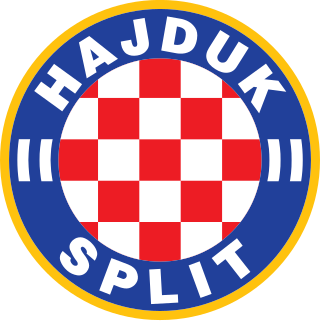Related Research Articles

Hrvatski nogometni klub Hajduk Split, commonly referred to as Hajduk Split, is a Croatian professional football club based in Split, that competes in the Croatian First League, the top tier in Croatian football. Since 1979, the club's home ground has been the 33,987-seater Stadion Poljud. The team's traditional home colours are white shirts with blue shorts and blue socks.

The Croatian Football Federation is the national governing body of football in Croatia. It was originally formed in 1912 and is based in the capital city of Zagreb. The organisation is a member of both FIFA and UEFA, and is responsible for overseeing all aspects of the game of football in Croatia. Marijan Kustić has served as president of the federation since 2021.

HŠK Građanski, also known as 1. HŠK Građanski or fully Prvi hrvatski građanski športski klub, was a Croatian football club established in Zagreb in 1911 and dissolved in 1945. The club had a huge influence on the development of football in Croatia and Kingdom of Yugoslavia and achieved its greatest success in the period between the two World Wars.
The 1990–91 Yugoslav First League season was the 45th season of the First Federal League, the top level association football competition of SFR Yugoslavia, since its establishment in 1946. The title was won by Red Star Belgrade, the club's 18th in its history. It also turned out to be the last season in which teams from SR Croatia and SR Slovenia participated. In 1991, these states left Yugoslavia and created their respective leagues.
The Yugoslav Volleyball Championship was the highest level of volleyball competition in SFR Yugoslavia, contested between 1945 and 1991. After the dissolution of Yugoslavia, the league was succeeded by the following competitions:

The Eternal derby, also called the Derby of Southeast Europe and Belgrade derby, is the local derby in Belgrade, capital of Serbia, between fierce city rivals Red Star Belgrade and Partizan Belgrade, two of the most popular and most successful clubs in Serbia, although the derby has caused division throughout the whole of Serbia. It has been described as "one of European football's most bitter rivalries".

Fudbalski klub Spartak Ždrepčeva Krv is a professional football club from Subotica, Serbia, that plays in the Serbian SuperLiga.
The Yugoslav Ice Hockey League was the top ice hockey league in the old Yugoslavia.
FK JRV Naša krila was a short-lived Yugoslav football club established in 1947 as a section of the eponymous sports society affiliated with the Yugoslav Air Force (JRV). Based in Zemun, SR Serbia, the club acted as the Air Force's official team, and relied on players serving their mandatory military service with the branch, also headquartered at Zemun.

Football in Yugoslavia had different levels of historical development depending on the geographical regions. Following the extreme popularity of the sport in Central Europe, it soon became the most popular sport in the territories of Yugoslavia as well.

Sport in Yugoslavia had a significant role in its culture and society. Team sports such as football, basketball, handball, volleyball and water polo had the biggest popularity. Of individual sports the most popular were tennis, athletics, alpine skiing, swimming, table tennis, ski jumping and chess. Yugoslavia made its debut at the Summer Olympics in 1920. Until its break up in 1992, it competed in 16 Summer and 14 Winter Olympic games and won a total of 87 medals in various summer and winter sports. Yugoslavia hosted its first and the only Winter Olympic games in 1984 in Sarajevo when Jure Franko won country's first Winter Olympic medal, silver in alpine skiing.
The 1989–90 Yugoslav First Basketball League season was the 46th season of the Yugoslav First Basketball League, the highest professional basketball league in SFR Yugoslavia.
The 1989–90 season was the 44th season in FK Partizan's existence. This article shows player statistics and matches that the club played during the 1989–90 season.
The 1946–47 season was the first season in FK Partizan's existence. This article shows player statistics and matches that the club played during the 1946–47 season.
The 1990–91 season was the 45th season in FK Partizan's existence. This article shows player statistics and matches that the club played during the 1990–91 season.
The 1959–60 season was the 14th season in FK Partizan's existence. This article shows player statistics and matches that the club played during the 1959–60 season.
The 1947–48 season was the second season in FK Partizan's existence. This article shows player statistics and matches that the club played during the 1947–48 season.
References
- ↑ Saga over As Dong Joins Man Utd at china.org.cn, 18-1-2007, Retrieved 5-4-2012
- ↑ Igor Kislov, international later in 1998 for Turkmenistan.
- ↑ Vladislav Neemescalo, international later in 1994 for Moldova.
- ↑ Белогвардейци са звездите ни в зората на футбола“, в-к „Меридиан Уикенд“, 22 октомври 2016 г., брой 284 (7759)
- ↑ Became the first foreigner to play for the Bulgaria national team as Fridrih Klud.
- ↑ Mykola Yurchenko, international, later in 1994 for Ukraine.
- ↑ Italian Players Abroad at RSSSF, retrieved 3-12-2019
- ↑ Czech and Slovak Players and Coaches in Italy at RSSSF, retrieved 3-12-2019 ; Note: It can be either Ferar Cluj or FC Universitatea Cluj, thus the link remains open for the club he played in. He joined during winter-break and played only second half of season, later moving in summer to Italy.
- ↑ Oļegs Karavajevs, international of Latvia since 1992.
- ↑ Mikhail Markhel, international of Belarus since 1994.
- ↑ Aliaksandr Metlitskiy, international of Belarus since 1992.
- ↑ Kęstutis Ruzgys, international for Lithuania since 1992.